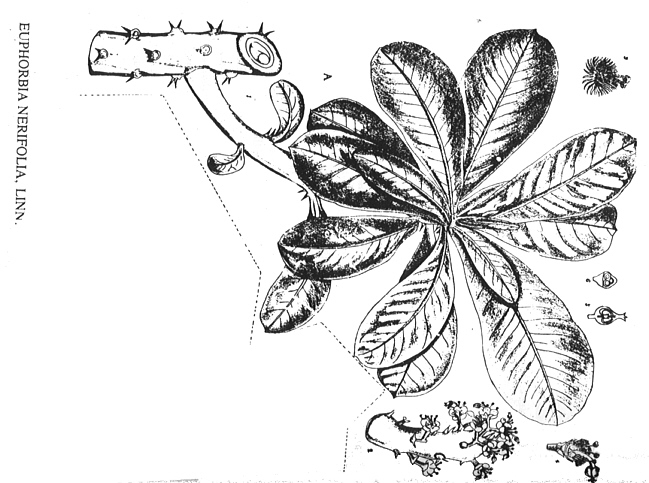

Zitierweise / cite as:
Carakasaṃhitā: Ausgewählte Texte aus der Carakasaṃhitā / übersetzt und erläutert von Alois Payer <1944 - >. -- Anhang A: Pflanzenbeschreibungen. -- Euphorbia neriifolia L. -- Fassung vom 2007-05-10. -- URL: http://www.payer.de/ayurveda/pflanzen/euphorbia_neriifolia.htm
Erstmals publiziert: 2007-03-19
Überarbeitungen: 2007-05-10
Anlass: Lehrveranstaltung SS 2007
©opyright: Dieser Text steht der Allgemeinheit zur Verfügung. Eine Verwertung in Publikationen, die über übliche Zitate hinausgeht, bedarf der ausdrücklichen Genehmigung des Verfassers
Dieser Text ist Teil der Abteilung Sanskrit von Tüpfli's Global Village Library
WARNUNG: dies ist der Versuch einer
Übersetzung und Interpretation eines altindischen Textes. Es ist keine
medizinische Anleitung. Vor dem Gebrauch aller hier genannten Heilmittel wird
darum ausdrücklich gewarnt. Nur ein erfahrener, gut ausgebildeter ayurvedischer
Arzt kann Verschreibungen und Behandlungen machen!
Falls Sie die diakritischen Zeichen nicht dargestellt bekommen, installieren Sie eine Schrift mit Diakritika wie z.B. Tahoma.
Verwendete und zitierte Werke siehe: http://www.payer.de/ayurveda/caraka0001.htm

Abb.: Euphorbia neriifolia L.
[Bildquelle: Kirtikar-Basu, ©1918]
Drury:
"Euphorbia ligularia (Roxb.) Do. Munsa sij, Beng.
Description.—Tree, 20 feet; young shoots 5-sided, somewhat spirally disposed, and armed with large teeth, each of which supports a leaf, and a pair of short, black, stipulary thorns; leaves alternate about the ends of the branches, wedge-shaped, waved, fleshy; peduncles solitary between the serratures of the angles of the branchlets, 1-3 dichotomous, with a larger sessile flower in the forks; petals 5, fringed with a ragged margin inserted into the calyx; flowers greenish yellow. Fl. Feb.—March.—Roxb. Fl. Ind. ii. 465.——Peninsula. Bengal.
Medical Uses—The root mixed with 1 lack pepper is employed in cases of snake-bites, both internally and externally. The plant is sacred to Munsa, the goddess of serpents. Every part abounds with an acrid milky juice, employed to remove warts and cutaneous eruption.—(Roxb.) In July and August, on Tuesdays and Thursdays, the natives approach this tree with offerings of rice, milk, and sugar, praying to be delivered from snake-bites. However, they employ a surer means by mixing the root with black pepper as a remedy in bites. The native doctors purify arsenic by making a hole in the trunk of the tree, filling it up with solid arsenic, and after being covered with the bark of the same plant, the whole is exposed to a good lire, until the external parts of the trunk are completely charred, when the arsenic is taken out and becomes fit for use.—Journ. of Agri. Hort. Soc. of India, x. 37."
[Quelle: Drury, Heber <1819 - 1872>: The useful plants of India : with notices of their chief value in commerce, medicine, and the arts. -- 2d ed. with additions and corrections. London : Allen, 1873. -- xvi, 512 p. ; 22 cm. -- s.v.]
Dutt:
"EUPHORBIA NERIIFOLIA, Linn. Syn. Euphorbia ligularia, Roxb.
Sans. Snuhi, Vajrī, Sehuṇḍa.
Vern. Mansāsij, Beng. Sehund, Thohar, Hind.This prickly shrub is sacred to Mansā the goddess of serpents. On the fifth day after full moon of the month of Sravana (July, August) it is planted in the court-yard of Hindu houses and worshipped as the representative of Mansā the goddess of serpents. Euphorbia, antiquorum, called tekāṭā sij in Bengali on account of its triangular stem, is probably alluded to by some Sanskrit writers under the name of vajri, which is explained as a variety of snuhi. This plant is supposed to ward off lightening strokes and is generally kept in tubs or pots on the roofs or other exposed parts of native houses. Its popular medicinal uses are like those of Euphorbia neriifolia.
The milky juice of Euphorbia neriifolia is considered purgative and rubefacient. As a purgative it is generally used in combination with other medicines which are steeped in it. Chebulic myrobalan, long pepper, trivrit root, etc., are thus treated and administered as drastic purgatives, in ascites, anasarca and tympanitis. It enters into the composition of several compound prescriptions of a drastic character as for example, the Mahānārācha rasa described under Croton Tiglium, and Vindu ghrita a preparation with clarified butter, of similar composition.
Turmeric powder mixed with the milky juice of Euphorbia neriifolia is recommended to be applied to piles. Thread steeped in the above mentioned mixture is used in ligaturing external haemorrhoids. The powdered wood of Berberis Asiatica (dāruharidrā) is steeped in the milky juice of snuhi and of Calotropis gigantea (arka), and made into tents for introduction into the tracks of fistula-in-ano and other sinuses."
[Quelle: Dutt, Uday Chand: The materia medica of the Hindus / Uday Chand Dutt. With a glossary of Indian plants by George King. -- 2. ed. with additions and alterations / by Binod Lall Sen & Ashutosh Sen. -- Calcutta, 1900. - XVIII, 356 S. -- S. 233f.]